World Roundup
May/June 2013


-
 HAWAII: Ten feet below the waters of the Midway Atoll are the remains of a broken, infamous, slightly stubby piece of aviation history. The wreckage is believed to be from a Brewster F2A-3 Buffalo, one of the United States’ first monoplane fighters, that went down in a squall in 1942, a few months before the Battle of Midway. Though Buffaloes (perhaps not the most inspiring name for an aircraft) saw action in the battle, they generally lived up to their reputation as “flying coffins.” —Samir S. Patel
HAWAII: Ten feet below the waters of the Midway Atoll are the remains of a broken, infamous, slightly stubby piece of aviation history. The wreckage is believed to be from a Brewster F2A-3 Buffalo, one of the United States’ first monoplane fighters, that went down in a squall in 1942, a few months before the Battle of Midway. Though Buffaloes (perhaps not the most inspiring name for an aircraft) saw action in the battle, they generally lived up to their reputation as “flying coffins.” —Samir S. Patel -
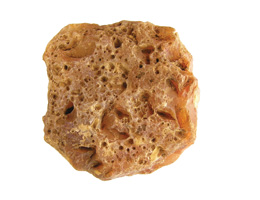 PANAMA: A rock collection represents the earliest known evidence for shamanistic practices in lower Central America. Between 4,000 and 4,800 years old, the group of 12 small pieces of crystal and other stones were found in the back of a rock shelter. Several show abrasions and other signs of use, and all were found in a tight pile, indicating they may once have been in a bag or basket. The belief system behind the cache is not known, but nearby modern indigenous groups also use unusual stones in rituals. —Samir S. Patel
PANAMA: A rock collection represents the earliest known evidence for shamanistic practices in lower Central America. Between 4,000 and 4,800 years old, the group of 12 small pieces of crystal and other stones were found in the back of a rock shelter. Several show abrasions and other signs of use, and all were found in a tight pile, indicating they may once have been in a bag or basket. The belief system behind the cache is not known, but nearby modern indigenous groups also use unusual stones in rituals. —Samir S. Patel -
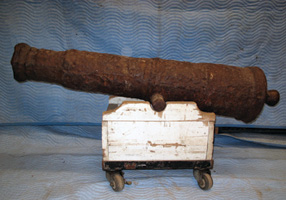 NEW YORK: Archaeology has its hazards—from snakes to bandits to falling rocks—but cannon fire is not usually among them. Workers cleaning a historic cannon that had once been on display in New York’s Central Park were startled to find that, after 200 years, it was still loaded. The cannon, which was once aboard the British warship HMS Hussar, was packed with a cannonball, wadding, and gunpowder (topped by a concrete plug to keep out litter), which were all safely removed. After cleaning, the cannon will be returned to display, with another chapter written in its long history. —Samir S. Patel
NEW YORK: Archaeology has its hazards—from snakes to bandits to falling rocks—but cannon fire is not usually among them. Workers cleaning a historic cannon that had once been on display in New York’s Central Park were startled to find that, after 200 years, it was still loaded. The cannon, which was once aboard the British warship HMS Hussar, was packed with a cannonball, wadding, and gunpowder (topped by a concrete plug to keep out litter), which were all safely removed. After cleaning, the cannon will be returned to display, with another chapter written in its long history. —Samir S. Patel -
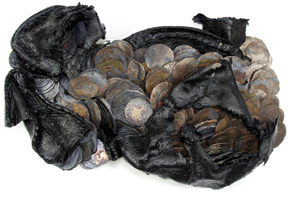 THE NETHERLANDS: In 16th-century Rotterdam, someone chose to save his money not in a mattress, but in his footwear. The well-preserved leather shoe, discovered in the excavation of a former City Hall site, contained almost 500 silver coins—about two months’ wages for a skilled craftsman at the time. The newest coin dates to 1592, during the Eighty Years' War for Dutch independence. The hoard may have been left in expectation of less turbulent times that the owner never lived to see. —Samir S. Patel
THE NETHERLANDS: In 16th-century Rotterdam, someone chose to save his money not in a mattress, but in his footwear. The well-preserved leather shoe, discovered in the excavation of a former City Hall site, contained almost 500 silver coins—about two months’ wages for a skilled craftsman at the time. The newest coin dates to 1592, during the Eighty Years' War for Dutch independence. The hoard may have been left in expectation of less turbulent times that the owner never lived to see. —Samir S. Patel -
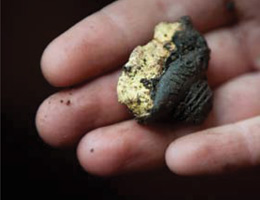 NORWAY: Painter Edvard Munch—known for his symbolic, expressionistic works, chief among them the iconic and anxiety-ridden The Scream (1893)—owned a home near Hvisten, a compact white house between forest and fjord. Excavations on the property have turned up thousands of objects from his time there, including paint and paint tubes that have helped pinpoint the locations of Munch’s four outdoor studios there. —Samir S. Patel
NORWAY: Painter Edvard Munch—known for his symbolic, expressionistic works, chief among them the iconic and anxiety-ridden The Scream (1893)—owned a home near Hvisten, a compact white house between forest and fjord. Excavations on the property have turned up thousands of objects from his time there, including paint and paint tubes that have helped pinpoint the locations of Munch’s four outdoor studios there. —Samir S. Patel -
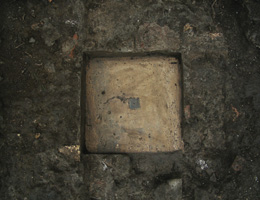 ITALY: Nineteenth-century physicist and astronomer Father Pietro Angelo Secchi studied the sun and the spectra produced by stars, but also, occasionally, looked down. A marble bench mark that Secchi placed—a slab of travertine fitted with a metallic plate with a hole in the center—has been discovered near the town of Frattocchie. Along with another bench mark about 7.5 miles away, it was used to survey the Appian Way and help measure the shape of Earth. —Samir S. Patel
ITALY: Nineteenth-century physicist and astronomer Father Pietro Angelo Secchi studied the sun and the spectra produced by stars, but also, occasionally, looked down. A marble bench mark that Secchi placed—a slab of travertine fitted with a metallic plate with a hole in the center—has been discovered near the town of Frattocchie. Along with another bench mark about 7.5 miles away, it was used to survey the Appian Way and help measure the shape of Earth. —Samir S. Patel -
 SERBIA: Electron spin resonance, uranium series isotopic analysis, and infrared/post-infrared luminescence dating—all these advanced techniques were applied to determine the age of a hominin jawbone found in a cave. The mandible, with three molars attached, is between 397,000 and 525,000 years old, placing it among the oldest hominin fossils in Europe. The sample, which lacks features associated with Neanderthals and may come from a Homo erectus, might help explain how these early human lineages evolved and were distributed across the continent. —Samir S. Patel
SERBIA: Electron spin resonance, uranium series isotopic analysis, and infrared/post-infrared luminescence dating—all these advanced techniques were applied to determine the age of a hominin jawbone found in a cave. The mandible, with three molars attached, is between 397,000 and 525,000 years old, placing it among the oldest hominin fossils in Europe. The sample, which lacks features associated with Neanderthals and may come from a Homo erectus, might help explain how these early human lineages evolved and were distributed across the continent. —Samir S. Patel -
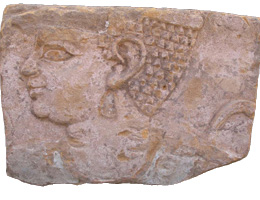 SUDAN: In the ancient city of Meroe in the kingdom of Kush, archaeologists have uncovered a relief of a smiling, carefully adorned woman. Indications of a slight double chin suggest that she carried a bit of extra weight, which is how royal women from Kush were often depicted. She could even be a queen or a princess, according to researchers, but determining that will require more study of the fragile palace where she was found. —Samir S. Patel
SUDAN: In the ancient city of Meroe in the kingdom of Kush, archaeologists have uncovered a relief of a smiling, carefully adorned woman. Indications of a slight double chin suggest that she carried a bit of extra weight, which is how royal women from Kush were often depicted. She could even be a queen or a princess, according to researchers, but determining that will require more study of the fragile palace where she was found. —Samir S. Patel -
 INDIA: Examination of faunal traces on ancient pots is a useful tool for understanding the diets of people thousands of years ago. The technique has now been used to trace curries—those staples of Indian cuisine—back to the Indus civilization, some 4,400 years ago. Using pots from the small Indus site of Farmana and teeth from a nearby cemetery, the researchers found evidence of cooked turmeric and ginger, two essential ingredients of curries even today. —Samir S. Patel
INDIA: Examination of faunal traces on ancient pots is a useful tool for understanding the diets of people thousands of years ago. The technique has now been used to trace curries—those staples of Indian cuisine—back to the Indus civilization, some 4,400 years ago. Using pots from the small Indus site of Farmana and teeth from a nearby cemetery, the researchers found evidence of cooked turmeric and ginger, two essential ingredients of curries even today. —Samir S. Patel -
 AUSTRALIA: Native Australians first arrived on the island continent more than 40,000 years ago. It has been widely believed that they were isolated, culturally and genetically, from the rest of the world prior to European contact in the 17th century. But there was always the question of who brought the dingo, which was introduced around 4,000 years ago. A new genetic analysis shows that there was actually substantial gene flow between India and Australia around this time, which also coincides with changes in tools and food-processing technology. —Samir S. Patel
AUSTRALIA: Native Australians first arrived on the island continent more than 40,000 years ago. It has been widely believed that they were isolated, culturally and genetically, from the rest of the world prior to European contact in the 17th century. But there was always the question of who brought the dingo, which was introduced around 4,000 years ago. A new genetic analysis shows that there was actually substantial gene flow between India and Australia around this time, which also coincides with changes in tools and food-processing technology. —Samir S. Patel
Advertisement
IN THIS ISSUE
Features
On the Trail of the Mimbres
Haunt of the Resurrection Men
The Kings of Kent
Letter from Turkey
From the Trenches
Albanian Fresco Fiasco
Off The Grid
Visions of Valhalla
Archaic Engineers Worked on a Deadline
Europe's First Farmers
A Pyramid Fit for a Vizier
Second to Whom?
Thracian Treasure Chest
A Major New Venue
A Killer Bacterium Expands Its Legacy
Bad Monks at St. Stephen's
Hail to the Bождь (Chieftain)
Oops! Down the Drain
From Egyptian Blue to Infrared
Advertisement

Recent Issues
-
 May/June 2024
May/June 2024
-
 March/April 2024
March/April 2024
-
 January/February 2024
January/February 2024
-
 November/December 2023
November/December 2023
-
 September/October 2023
September/October 2023
-
 July/August 2023
July/August 2023
-
 May/June 2023
May/June 2023
-
 March/April 2023
March/April 2023
-
 January/February 2023
January/February 2023
-
 November/December 2022
November/December 2022
-
 September/October 2022
September/October 2022
-
 July/August 2022
July/August 2022
-
 May/June 2022
May/June 2022
-
 March/April 2022
March/April 2022
-
 January/February 2022
January/February 2022
-
 November/December 2021
November/December 2021
-
 September/October 2021
September/October 2021
-
 July/August 2021
July/August 2021
-
 May/June 2021
May/June 2021
-
 March/April 2021
March/April 2021
-
 January/February 2021
January/February 2021
-
 November/December 2020
November/December 2020
-
 September/October 2020
September/October 2020
-
 July/August 2020
July/August 2020
-
 May/June 2020
May/June 2020
-
 March/April 2020
March/April 2020
-
 January/February 2020
January/February 2020
-
 November/December 2019
November/December 2019
-
 September/October 2019
September/October 2019
-
 July/August 2019
July/August 2019
-
 May/June 2019
May/June 2019
-
 March/April 2019
March/April 2019
-
 January/February 2019
January/February 2019
-
 November/December 2018
November/December 2018
-
 September/October 2018
September/October 2018
-
 July/August 2018
July/August 2018
-
 May/June 2018
May/June 2018
-
 March/April 2018
March/April 2018
-
 January/February 2018
January/February 2018
-
 November/December 2017
November/December 2017
-
 September/October 2017
September/October 2017
-
 July/August 2017
July/August 2017
-
 May/June 2017
May/June 2017
-
 March/April 2017
March/April 2017
-
 January/February 2017
January/February 2017
-
 November/December 2016
November/December 2016
-
 September/October 2016
September/October 2016
-
 July/August 2016
July/August 2016
-
 May/June 2016
May/June 2016
-
 March/April 2016
March/April 2016
-
 January/February 2016
January/February 2016
-
 November/December 2015
November/December 2015
-
 September/October 2015
September/October 2015
-
 July/August 2015
July/August 2015
-
 May/June 2015
May/June 2015
-
 March/April 2015
March/April 2015
-
 January/February 2015
January/February 2015
-
 November/December 2014
November/December 2014
-
 September/October 2014
September/October 2014
-
 July/August 2014
July/August 2014
-
 May/June 2014
May/June 2014
-
 March/April 2014
March/April 2014
-
 January/February 2014
January/February 2014
-
 November/December 2013
November/December 2013
-
 September/October 2013
September/October 2013
-
 July/August 2013
July/August 2013
-
 May/June 2013
May/June 2013
-
 March/April 2013
March/April 2013
-
 January/February 2013
January/February 2013
-
 November/December 2012
November/December 2012
-
 Sep/Oct 2012
Sep/Oct 2012
-
 September/October 2012
September/October 2012
-
 July/August 2012
July/August 2012
-
 May/June 2012
May/June 2012
-
 March/April 2012
March/April 2012
-
 January/February 2012
January/February 2012
-
 November/December 2011
November/December 2011
-
 September/October 2011
September/October 2011
-
 July/August 2011
July/August 2011
-
 May/June 2011
May/June 2011
-
 March/April 2011
March/April 2011
-
 January/February 2011
January/February 2011
Advertisement






